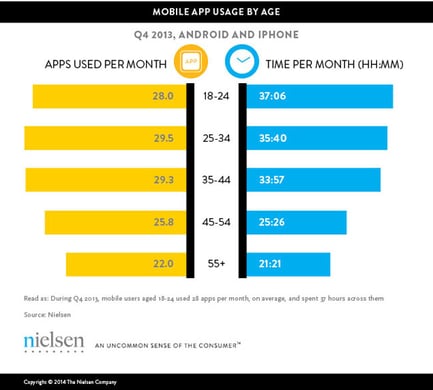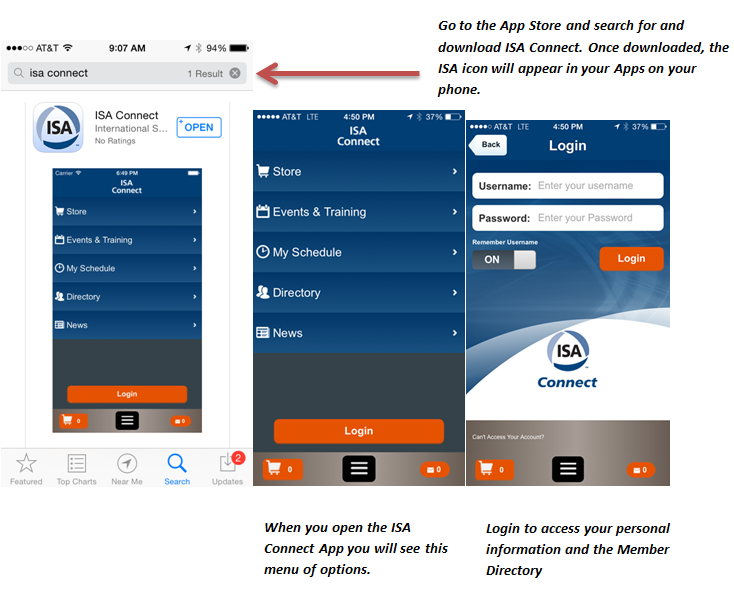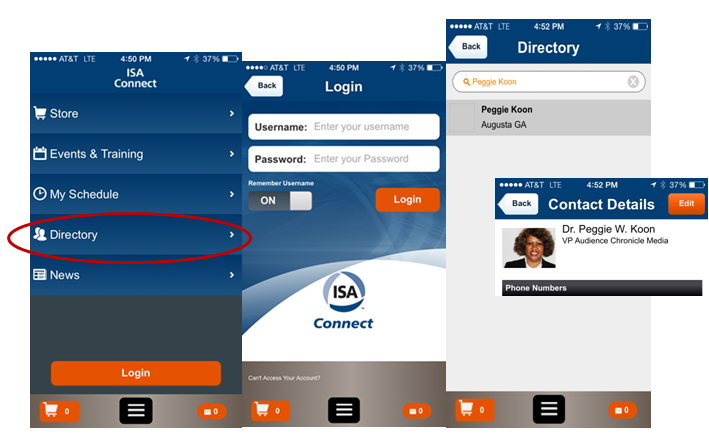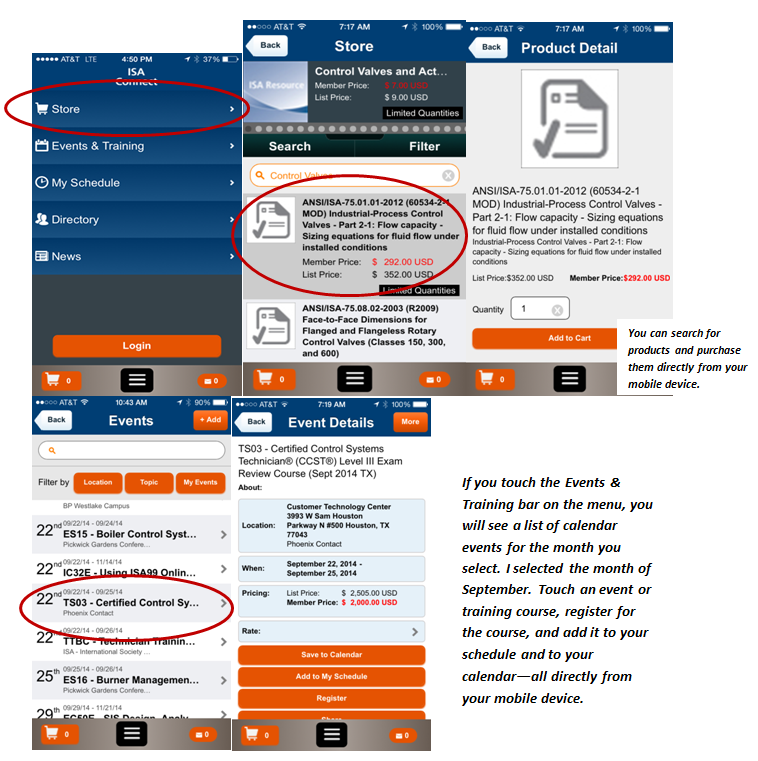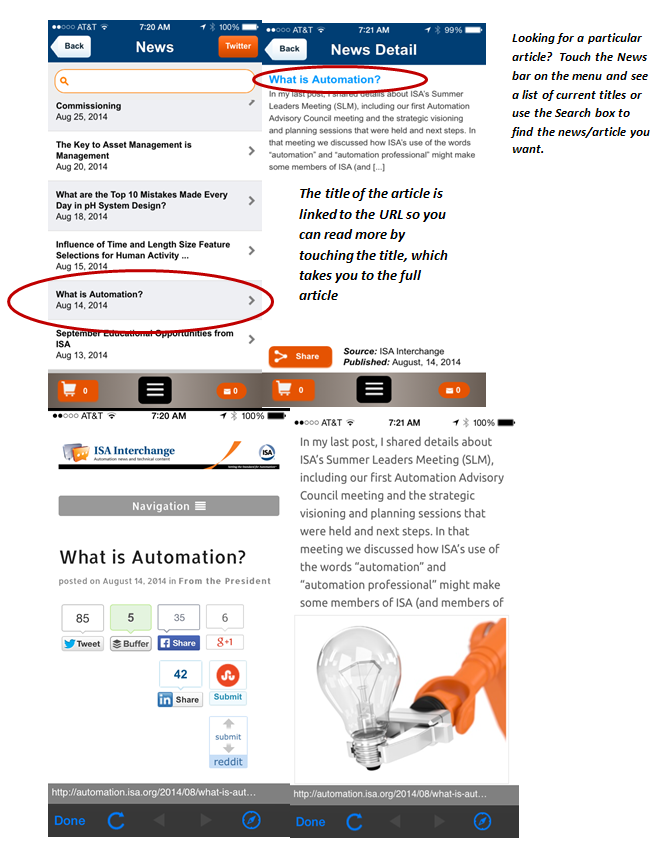This post is authored by Peggie Koon, president of ISA 2014.
For the past several months I have been focusing my articles on ISA’s five game-changing strategic goals. One of those goals – using the coolest delivery to connect people and knowledge—is of particular interest to me.
What does it mean to have “cool” delivery of our content? And why is cool delivery important? 
To be sure, the notion of doing something in a “cool” way is subjective. The phrase is not new and has many meanings. An engineer might think of “cool” in reference to controlling temperature – not too hot or too cold. But if we move away from traditional thinking, the use of the word “cool,” especially when we refer to ISA’s content delivery, might be better understood if we look at what Meriam Webster refers to as an “informal” meaning. See what the online reference says:
1 cool /ˈkuːl/ adjective
[or more cool; most cool] informal
a : very fashionable, stylish, or appealing in a way that is generally approved of especially by young people
- cool sunglasses
- The car has a cool new look.
- You look cool in those jeans.
- a magazine article about the coolest places to live/work
— often used to show approval in a general way
- Your brother is so cool.
- That was a really cool [=good, excellent] movie.
- “I got a job as a lifeguard this summer.” “Cool.”
b — used to suggest acceptance, agreement, or understanding
- “I'm sorry I'm late.” “It's/That's cool [=okay, all right]—don't worry about it.”
- “Is getting together Friday cool with you?” “Yeah, I'm cool with that.”
- I thought she'd be mad, but she was cool about it. (See more at http://www.learnersdictionary.com/definition/cool )
Note that I highlighted the words “good, excellent” and the phrase “appealing in a way that is generally approved of especially by young people” from this definition because these concepts embody, at least for me, one part of the rationale for setting a goal of having coolest delivery of our content. Using this definition then, the goal becomes: “delivering good, excellent content that is appealing in a way generally approved of, especially by young people.”
Cool delivery is also a part of ISA’s goal to be market driven. As we continually look at changing trends related to which products and services are needed in the markets we serve (or might serve in the future), we must also be ever cognizant of changing trends in how those products and services are being consumed.
Technology is a key enabler of both these changes. And one of these technologies, the mobile device, is changing everything—especially how people connect with other people and with information, products, and services. To put the impact of mobile technology in perspective, consider these fast facts from the Pew Internet Project’s research related to mobile technology (Read more at: http://www.pewinternet.org/fact-sheets/mobile-technology-fact-sheet/ )
Device Ownership Over Time
As of January 2014:
- 90% of American adults have a cell phone
- 58% of American adults have a smartphone
- 32% of American adults own an e-reader
- 42% of American adults own a tablet computer
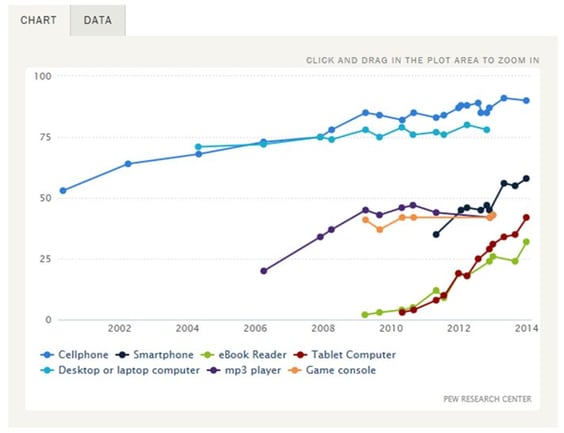 Other facts from the report include:
Other facts from the report include:
- 67% of cell owners find themselves checking their phone for messages, alerts, or calls—even when they don’t notice their phone ringing or vibrating.
- 44% of cell owners have slept with their phone next to their bed because they wanted to make sure they didn’t miss any calls, text messages, or other updates during the night.
- 29% of cell owners describe their cell phone as “something they can’t imagine living without.”
According to the report, as of May 2013, 63% of adult cell owners use their phones to go online.
34% of cell internet users go online mostly using their phones, and not using some other device such as a desktop or laptop computer.
How Americans use their cell phones (activities):
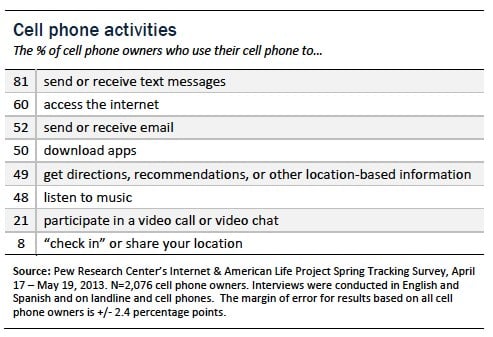 The report also says that cell phone users access “Just in time” information:
The report also says that cell phone users access “Just in time” information:
An April 2012 survey found that “some 70% of all cell phone owners and 86% of smartphone owners used their phones in the previous 30 days to perform at least one of the following activities:
- Coordinate a meeting or get-together—41% of cell phone owners have done this in the past 30 days.
- Solve an unexpected problem that they or someone else had encountered—35% have used their phones to do this in the past 30 days.
- Decide whether to visit a business, such as a restaurant—30% have used their phone to do this in the past 30 days.
- Find information to help settle an argument they were having—27% have used their phone to get information for that reason in the past 30 days.
- Look up a score of a sporting event—23% have used their phone to do that in the past 30 days.
- Get up-to-the-minute traffic or public transit information to find the fastest way to get somewhere—20% have used their phone to get that kind of information in the past 30 days.
- Get help in an emergency situation—19% have used their phone to do that in the past 30 days.
Overall, these “just-in-time” cell users—defined as anyone who has done one or more of the above activities using their phone in the preceding 30 days—amount to 62% of the entire adult population.”
So what does this really mean?
According to the folks at www.dazeinfo.com, “ global smartphone audience surpassed the 1 billion mark in 2012 and will total 1.75 billion in 2014. eMarketer expects smartphone adoption to continue on a fast-paced trajectory through 2017……
The report titled Smartphone Users Worldwide 2012 – 2017 from eMarketer, further expects that around two-fifths of all mobile phones, i.e. around one fourth of the world’s population, used a smartphone at least monthly this year.
The mobile phone market, which was 4.08 billion users globally in 2012, grew by 6.2% in 2013 to 4.33 billion users. The mobile market is supposed to grow by 5.1% to 4.55 billion users in 2014 and further by 4.7% to 4.77 billion users. The total mobile phone users are likely to reach 5.13 billion users globally by 2017.”
“In 2012 around 1.58 billion users used their mobile phones for internet, which is around 67% of internet users. The number of users using mobile phones for internet grew by 21% to 1.91 billion users, which is around 74% of internet users. This number is further expected to increase by 17% in 2014 to 2.23 billion users, which is around 79% of total internet users. By 2017 around 2.97 billion users are expected to use the internet over their phones, which is around 91% of total internet users and 58% of mobile phone users. In the near future, the Smartphone would become our primary way of connecting to the internet and Smartphone users would access major applications and data from their mobile devices.”
Also according to Phil Tran, “Every month, smartphone users spend an average of 30.25 hours on 26.8 apps.”
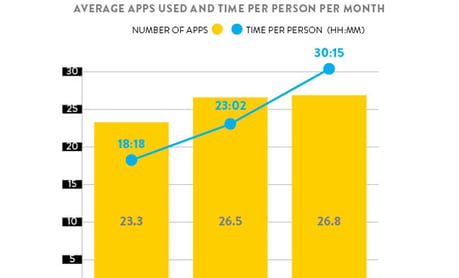 Phil says, “It’s good to be a popular smartphone app. According to the latest Nielsen report, on average, a smartphone user is accessing 26.8 apps every month for about 30.25 hours. That’s 65 percent more than two years ago…”
Phil says, “It’s good to be a popular smartphone app. According to the latest Nielsen report, on average, a smartphone user is accessing 26.8 apps every month for about 30.25 hours. That’s 65 percent more than two years ago…”
The article goes on to say: “Not surprisingly, the highest amount of time spent on apps goes to the young age group in the survey: 18- to 24-year-olds. They spent approximately 37 hours and six minutes while those older than 55 spent only 21 hours and 21 minutes.”
So what does this mean for ISA?
Almost all of our products, particularly our training materials, publications, standards, technical papers, etc., are currently available via print and/or online. Like many organizations, we have traditionally assumed that members of ISA and/or members of the automation community will engage with us via the www.isa.org website, call, or email us. And for the most part, we assume that these professionals will consume our products in much the same way. We are like so many people in our sphere of influence who have proclaimed “This is how we do it!”
And I am not unlike many of you. I like to read an article from end to end, I want to download a standard or technical paper, preferably as a PDF—then print it out. Yes, I said it! I am in love with print!!!
But here’s the reality! If we look at this information and the data analytics that support it, folks in the all age groups engage in mobile technology and are using apps.
ISA has an opportunity to provide products and services in the mobile space. And we should respond to it! It’s exciting to know that our Society is doing just that!
ISA is actively using mobile technology to connect people to ISA content, products, and services—responding to the trends mentioned above and achieving our strategic goal of providing the coolest delivery of our content in the automation industry.
What’s so “cool” about the delivery of ISA’s products and services?
By now, you should all know about and should have already downloaded ISA’s InTech+ Plus App for iPad.
Just the other day I discovered something new in the App store. It’s called ISA Connect and it’s really cool. Here’s a quick tour of the App:
Using the Directory feature of the App you can look up ISA members using the Search function, find their contact information, and connect with them instantly via your smartphone
There are other cool features, too, using the Store, Events & Training, and News tabs. Here are a few screen shots that illustrate the functionality of the ISA Connect App. After you take this quick tour, you’ll want to download it on your phone and check it out for yourself!
Is this cool?
It depends on your perspective. Remember, I started this article with a definition of cool, noting that its meaning is subjective. As you think about “cool delivery” keep in mind that a part of this subjectivity is directly related to our ability as individuals to allow ourselves to embrace the new ways content is being delivered by our Society.
For example, if you really don’t use your smart phone that much and you don’t want to download the ISA Connect app, you might complain that the ISA Directory is now only available via a mobile device and not on the website. If you’re caught up in the paradigm of looking up a phone number or email address of a colleague via the website, then calling them via your land line or emailing them via your desktop, you might miss the “coolness” of the app—the convenience of being able to look up an ISA colleague via your mobile device—anywhere, anytime—and having the ability to call them by just touching their phone number or to email them by just touching their email address!
How cool is that? Way cool!
Last month I wrote an article, “What is Automation?” and in the article I noted that ISA defines automation as: “the creation and application of technology to monitor and control the production and delivery of products and services.” (Read more at https://automation.isa.org/2014/08/what-is-automation/)
It’s very good – very cool—that ISA is leading the way using technology to deliver its products and services…Take a moment to think about this statement.
What’s next?
ISA, like so many other organizations, must continue to learn new ways to monetize in the mobile space. According to TechCrunch: “Gartner said it expects global mobile advertising spending to reach $18 billion this year, up from the estimated $13.1 billion in 2013. By 2017 it’s projecting the market will have sized up to be worth $41.9 billion.” The article also says: “In terms of mobile ad types, video will show the highest growth—with the category being driven by tablets and growth in tablet ownership —but display formats are expected to make up the most revenue.” (Read the full article at: http://techcrunch.com/2014/01/21/mobile-ad-market-forecast-to-2017/ )
I can see the duck…can you?
As leaders of ISA we are committed to providing coolest delivery, which I defined in my article “Can you see the duck?” as:
Coolest Delivery – ISA will deliver content using the coolest technology available. This means using technology so that our content can be easily consumed by next-generation automation professionals. (Read more at: https://automation.isa.org/2014/07/isa-vision-2020/ )
ISA’s new mobile apps InTech+ Plus and ISA Connect are just two ways your Society is fulfilling its goal to use the coolest technology available to deliver our excellent content, products, and services.
What about you? What can you do?
If you have not already done so, you can start by downloading ISA’s cool mobile apps – InTech+Plus and ISA Connect. And if you have additional ideas about cool delivery of ISA content—products and services—or about monetization in the mobile space, please let us know.
Email me at president@isa.org. I’d love to hear from you!
Get involved!
About the Author Peggie Koon, Ph.D., is vice president of audience at Chronicle Media and The Augusta Chronicle, which are part of Morris Publishing Group, LLC, a privately held media company based in Augusta, Ga. Prior to joining Morris, Peggie spent more than 25 years developing IT systems for process automation and process control in a variety of industries, including automotive, nuclear defense, aerospace, nuclear reprocessing, thermal ceramics and textiles. Peggie assumed her first ISA leadership position in 1996 as membership chair of the Management Division and has held a variety of prominent leadership roles in the Society. She earned a bachelor's degree in mathematics from Smith College in Northampton, Mass. and completed graduate studies in industrial and systems engineering at the Georgia Institute of Technology. She received a doctorate in management information systems from Kennedy Western University in Cheyenne, Wyo.
Peggie Koon, Ph.D., is vice president of audience at Chronicle Media and The Augusta Chronicle, which are part of Morris Publishing Group, LLC, a privately held media company based in Augusta, Ga. Prior to joining Morris, Peggie spent more than 25 years developing IT systems for process automation and process control in a variety of industries, including automotive, nuclear defense, aerospace, nuclear reprocessing, thermal ceramics and textiles. Peggie assumed her first ISA leadership position in 1996 as membership chair of the Management Division and has held a variety of prominent leadership roles in the Society. She earned a bachelor's degree in mathematics from Smith College in Northampton, Mass. and completed graduate studies in industrial and systems engineering at the Georgia Institute of Technology. She received a doctorate in management information systems from Kennedy Western University in Cheyenne, Wyo.
Connect with Peggie:![]()
![]()
![]()
A version of this article also has been published in ISA Insights.


